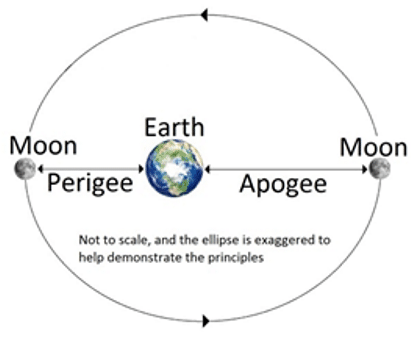BACKGROUND:
The
Moon and the Earth are held together by gravity.
The Earth is much
more massive than the Moon causing the Moon to orbit the Earth. The Moon
revolves (orbits) eastward looking in the sky from Earth. Each orbit takes 27.3 days. The Moon
also rotates, or spins on an internal axis once every 27.3 days. The
rotation and revolution
take the same amount of time generally due to gravitational
attraction of the Moon to the Earth. It makes one rotation per revolution.
The Earth/Moon system also revolves around the Sun, taking 365.25 days (or a
year) to complete one orbit.
The Moon’s orbit around the Earth is slightly
elliptical or oval-shaped. At its closest point (perigee), the Moon is
363,000 kilometers from the Earth. At its maximum distance (apogee),
the Moon is 405,000 kilometers away.

The elliptical orbit of the Moon may reflect its
origin. Current evidence suggests that the Moon formed after the collision
of the Earth with a protoplanet early in the Solar System’s history. The
debris from this collision coalesced to form the Moon. Computer models
suggest that the early orbit of the Moon may have been highly elliptical,
and became rounder with time. Due to the rotation, both the Earth and
Moon are
slightly wider at the equator than between the poles. They are not perfect
spheres, which makes their orbits a little erratic. The Moon’s internal structure is slightly uneven, which would
also contribute to an elliptical orbit. Finally,
The gravitational forces between the
Earth and the Moon cause some interesting effects. The most obvious is the tides. The Moon's gravitational attraction is stronger on the side of the
Earth nearest to the Moon and weaker on the opposite side. Since the Earth,
and particularly the oceans, is not perfectly rigid it is stretched out
along the line toward the Moon. From our perspective on the Earth's surface
we see two small bulges, one in the direction of the Moon and one directly
opposite. The effect is much stronger in the ocean water than in the solid
crust so the water bulges are higher.
Actually, the Moon appears to wobble a
bit (due to its slightly non-circular orbit) so that a few degrees of the
far side can be seen from time to time, but the majority of the far side was
completely unknown until the Soviet spacecraft Luna 3 photographed it in
1959. Note: there is no "dark side" of the Moon; all parts of the
Moon get sunlight half the time (except for a few deep craters near the
poles). Some uses of the term "dark side" in the past may have
referred to the far side as "dark" in the sense of
"unknown" (i.e. "darkest Africa") but even that meaning
is no longer valid today!
PROCEDURE:
- This lab comprises 4 stations, each of which has questions for the
students to answer. Each station helps to understand a different concept
in the relationship of the Earth/Moon system. Set up the stations as
described in the Lab below. You may want to make multiple sets for each
stations, to allow the students to work more quickly.
- Explain the rotations and revolutions of the Earth/Moon system to the
students. The Moon revolves around the Earth due to the gravitational attraction
between the two.
- Have the students work in groups, and answer the questions on the
worksheet.
ANSWERS:
STATION A. stretchy substance with a handle
- An elliptical orbit can be created at a high speed.
- A circular orbit forms at lower speeds.
- The Moon’s orbit is elliptical, but not eccentric (more
elongated). The Moon orbits the Earth because the latter is much
more massive. The reason for the shape of the orbit is unclear, but
relates to how the Earth/Moon system has evolved through
time.
- Gravity holds the Earth and Moon together.
STATION B. plain styrofoam ball, styrofoam ball with pin
- The students should realize that a spherical object will roll in a
straight line, but once a sphere becomes oblate (its center of mass
is offset from its center), its travel path will change. This is
like the Earth/Moon relationship; both bodies are not perfectly
spherical, so their rotations and revolutions are slightly distorted
or they wobble.
STATION C. 2 styrofoam balls with handles
The students should visualize that the Moon revolves around the
Earth, and both the Earth and the Moon rotate.
- The small styrofoam ball is the Moon.
- The Earth is the large ball.
- Students may have difficulty showing revolution, until they try
putting one ball upside down.
STATION D. Solar System (Illuminated Orbiter)
Students should be able to see that this planetarium does not show
distances correctly. However, it does show the correct Moon/Earth
relationships. They may also note that only Venus, Earth, and the Moon
are included; the other planets are missing. They may also make silly
comments, such as the Sun is not a light bulb!